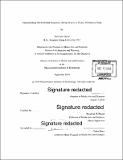| dc.contributor.advisor | Rosalind W. Picard. | en_US |
| dc.contributor.author | Taylor, Sara Ann | en_US |
| dc.contributor.other | Program in Media Arts and Sciences (Massachusetts Institute of Technology) | en_US |
| dc.date.accessioned | 2017-03-20T19:39:38Z | |
| dc.date.available | 2017-03-20T19:39:38Z | |
| dc.date.copyright | 2016 | en_US |
| dc.date.issued | 2016 | en_US |
| dc.identifier.uri | http://hdl.handle.net/1721.1/107551 | |
| dc.description | Thesis: S.M., Massachusetts Institute of Technology, School of Architecture and Planning, Program in Media Arts and Sciences, 2016. | en_US |
| dc.description | Cataloged from PDF version of thesis. | en_US |
| dc.description | Includes bibliographical references (pages 97-100). | en_US |
| dc.description.abstract | Electrodermal activity (EDA) refers to the electrical activity measured on and under the surface of the skin and has been used to study sleep, stress, and mood. While gathering this signal was once confined to the laboratory, it can now be acquired in ambulatory studies through commercially available wearable sensors. In this thesis, we model and analyze electrodermal response (EDR) events (1-5 second peaks in the EDA signal) during sleep in an ambulatory study. In particular, we describe an EDR event detection algorithm and extract shape features from these events to discuss the difference in shape between sleep and wake. We also describe an automatic artifact detection algorithm that we use on over 100,000 hours of EDA data we have collected in the 30-day SNAPSHOT Study from 164 participants. Finally, we model the detected EDR events as a point process using a state-space generalized linear model. We identify a significant influence of recent EDR event history on current EDR event likelihood across different participants. We also use this model to analyze EDR event rates during different periods of the night. | en_US |
| dc.description.statementofresponsibility | by Sara Ann Taylor. | en_US |
| dc.format.extent | 100 pages | en_US |
| dc.language.iso | eng | en_US |
| dc.publisher | Massachusetts Institute of Technology | en_US |
| dc.rights | MIT theses are protected by copyright. They may be viewed, downloaded, or printed from this source but further reproduction or distribution in any format is prohibited without written permission. | en_US |
| dc.rights.uri | http://dspace.mit.edu/handle/1721.1/7582 | en_US |
| dc.subject | Program in Media Arts and Sciences () | en_US |
| dc.title | Characterizing electrodermal responses during sleep in a 30-day ambulatory study | en_US |
| dc.title.alternative | Characterizing EDR during sleep in a 30-day ambulatory study | en_US |
| dc.type | Thesis | en_US |
| dc.description.degree | S.M. | en_US |
| dc.contributor.department | Program in Media Arts and Sciences (Massachusetts Institute of Technology) | en_US |
| dc.identifier.oclc | 974638475 | en_US |
